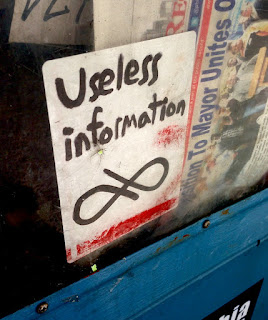When Justin Fox surveyed a number of financial analysts to learn what their least favorite economic indicator was back in 2010, most identified them dispassionately. Being analysts, of course, that's to be expected.
But some can be remarkably passionate about data they believe doesn't tell them anything useful. When we widened our current day search for the most useless economic statistic, we came across Jim Bianco's glorious 2012 diatribe against the Consumer Confidence Index at The Big Picture.
Because Bianco is a talented analyst, he makes his point, convincingly with data and charts. It really is worth clicking through to read Bianco's commentary, so we won't try to excerpt much of it, but here is a succinct summary of what Bianco finds the Consumer Confidence Index does not tell us about that you might think it would:
- Non-farm Payroll Jobs
- Employment Conditions
- Retail Sales
And here's what Bianco argues it does tell us about:
- The Stock Market (S&P 500)
He faults the survey questions the respondents to the survey used to determine the Consumer Confidence Index are asked to answer:
To most Americans these questions are too abstract. It is like asking them, “what is the weather in the United States and what do you expect the weather of the United States to be?” How does one answer this? You would probably look out the window and describe what you see.
The consumer confidence questions are being answered in a similar manner. Respondents don’t really know how to answer such abstract questions as business and employment conditions, so they describe what they think is the ultimate economic indicator, the stock market’s recent movements. While spikes in gas prices or other economic events (i.e., 9/11, “The Great Recession”) will supersede this method at times, most of the time the stock market is used to formulate answers to the above questions. In the last few months the stock market is up strongly, so it should not be a surprise that consumer confidence is up as well.
Since we do not need an indicator to highlight recent stock market performance, the Consumer Confidence Index becomes rather useless as an economic indicator. If it measures nothing more than recent stock market performance, economists should not be puzzled by the lack of a relationship between something like retail sales and consumer confidence. Consumer confidence and retail sales no longer relate.
In politics, the equivalent in uselessness is the Presidential Approval Rating, which has historically worked much the same way. Except instead of the stock market, the approval rating is often more about what Americans think about gas prices.
In his 2012 analysis, Bianco presented charts to illustrate a generally strong correlation between the level of the S&P 500 and the Consumer Confidence Index from 1999 through 2011. The main exception is the period coinciding with the bursting of the housing bubble in 2006 through the so-called "Great Recession" in 2009, where Americans had other factors weighing on their assessment.
Five years later, Bianco's basic hypothesis still rang true, as Bianco updated his chart illustrating the correlation through mid-2017.
But what about between then and now? We've put together the following chart to show the correlation between the U.S.' Consumer Confidence Index and the S&P 500 from January 2014 through April 2023.
We chose this period to present a few years of overlap between Bianco's 2017 chart with the available data in the years since. What we find is that Bianco's close correlation between the Consumer Confidence Index and the S&P 500 holds up until shortly after the Coronavirus Pandemic Recession began in March 2020.
Then, like after the housing bubble burst in 2006, we see other factors affecting how Americans respond to the Consumer Confidence survey questions. Overall, we see the two follow the same up and down pattern, but that changed noticeably starting from April 2021.
That's when stock prices and the consumer confidence index diverge, with stock prices rising while consumer confidence falls. That divergence coincides with the arrival of inflationary pressures in the U.S. economy.
The S&P 500 and consumer confidence kept moving on divergent tracks until after December 2021, when stock prices changed direction and began falling. That coincides with Wall Street's expectation the Federal Reserve would respond to the escalating inflation with interest rate hikes in early 2022.
Both measures would then go on to reverse and begin rising in the July-October 2022 time frame, shortly after fuel prices peaked and began to fall.
So what does all this mean? Under what we'll call "normal conditions", we'll agree with Bianco's assessment that consumer confidence doesn't tell us anything we cannot divine by watching stock prices. The Consumer Confidence Index is, dare we say, mostly useless indicator in that situation.
But when conditions are not normal, those rare times when it diverges from its correlation with stock prices, we think it may actually be more useful. If for nothing else than to confirm more extraordinary things are occurring within the U.S. economy.
Then again, that's something we can verify more directly and more easily from other data. Analysts trying to divine significance from consumer confidence data or from the closely-related consumer sentiment data aren't adding meaningful value to the world from their exercise.
Image credit: Useless information by Curly via Flickr. Creative Commons. Attribution-NonCommercial 2.0 Generic License (CC BY-NC 2.0).

